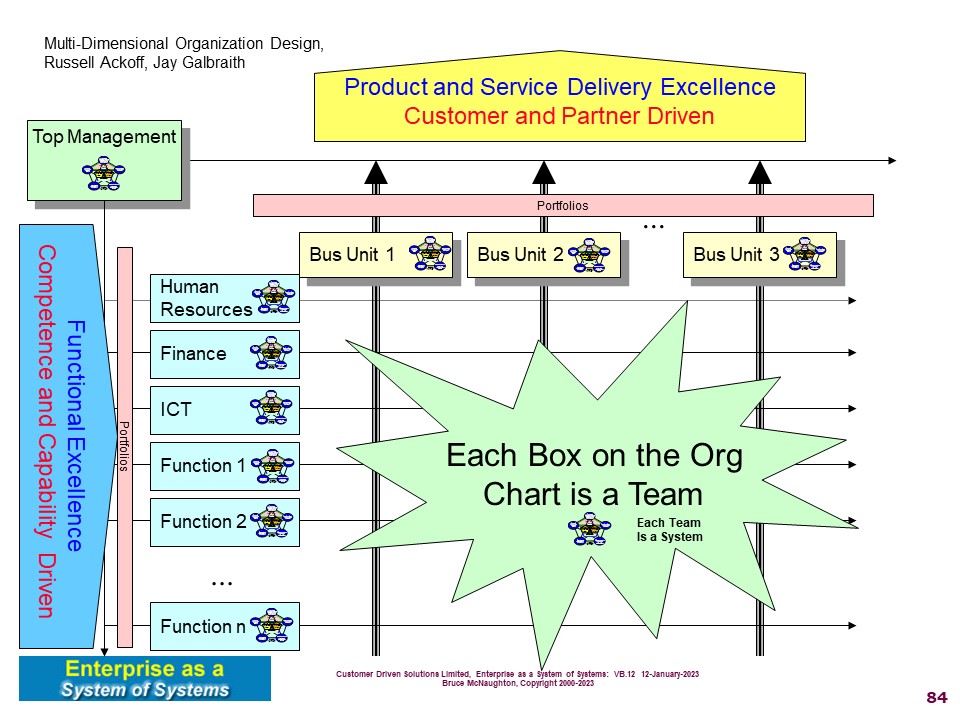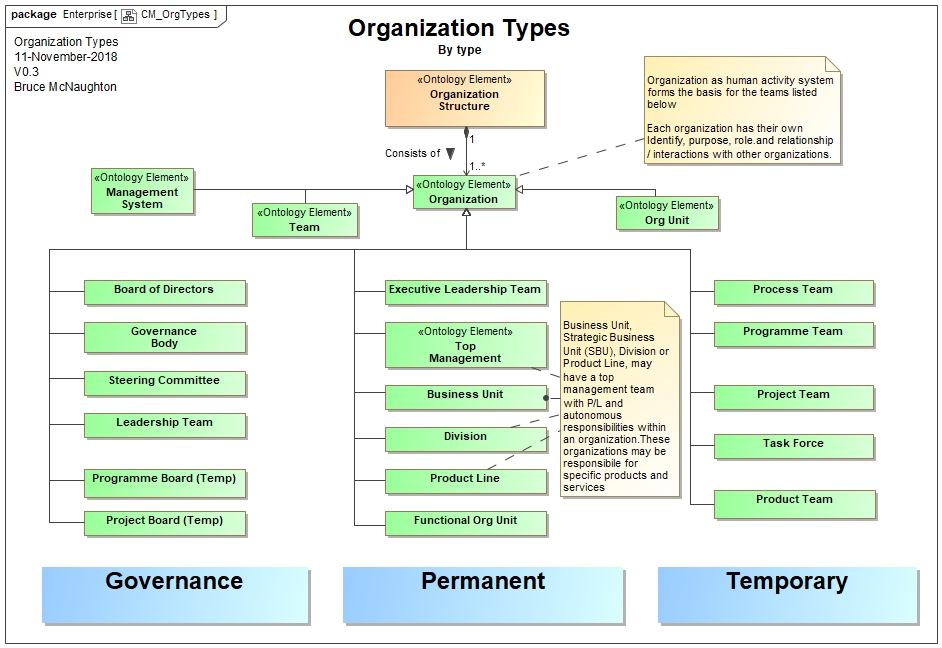System Element: Organizational Structure
The Organizational Structure is an essential system element of an Organization. Organizations of all sizes require a way to allocate and coordinate the people and other resources to achieve the objectives. The organization structure provides a way to allocate responsibility and authority across the organization. Each manager must design the organization to achieve these objectives. The manager carries out the organizing Activities of a Manager.
The result of organising is the creation of one or more teams with managers that are organized to achieve the objectives.
A typical representation of an Organization Chart is shown in the following diagram:

Each box on the organization chart represents an "Org Unit" (typically permanent) or a "Team" (typically temporary). An "Org Unit" or a "team" are a basic type of organization. An organization may consist of a collection of "Org Units" or "teams". Each "Org Unit" or "Team" is represented as a box on an organization chart.
The organization chart identifies the context of an "Org Unit" or "Team". The positioning may be hierarchical or using other relationships. The structure is generally shown in an Organization Chart. Today, these may take on many forms:
- Traditional Triangle
- Upside down Triangle
- Circles / Hub
- Matrix
- Multi-Dimensional Matrix
and probably a lot more...
The concept of multi-dimensional organizational design focuses on structures where minimal changes to the structure are required when responding to a change in the organization. This ensures that teams can be created, replicated moved, or released without impacting the overall structure of the organization. An example of a two dimensional structure is shown below.
The structure can have an impact on the way decisions or work activities are carried out. This means that job design, job enrichment , as well as process design (activities and decisions) can impact the performance of work. This type of structure also allows additional business units to be added and share the capabilities and functions that may already exist.
The following diagram shows a list of Organization Types:

The First Team or Top Management or Executive Leadership Team
ISO 9000:2015: Top Management Team: person or group of people who directs and controls an organization at the highest level
The Top Management Team is the highest team in an Organizational structure (in the example above the upper left box). This team establishes the boundaries between the environment (outside of the Organization). This team also establishes the plan for the organization which includes the purpose of the organization in line with the Enterprise.
Each team in the structure demonstrates their contribution to the elements set by top management.
The Top Management Team establishes the scope, purpose and objectives of the Organization. This organization may take on the role of central organization in a Value System. The organization may also be internal to the central organization and be a Business Unit, a Product Line, a division. These types of organizations may have their own
-
Integrated Management System
-
Set of products and services that they deliver
-
Business Plan and / or P/L and be autonomous
See Team Performance Management see Drucker and the practices of management.
Allocation of Organizational Capabilities and Resources to "Org Units" or "Teams"
The organizational structure highlights how the capabilities are allocated to "org units" or "teams". This allows for the following decisions to be made that will impact on organization performance:
- Autonomy of the org units or teams relative to decision making
- Degree of interdependence across the various org units or teams
- The amount of coordination across the instances of the same capability (e.g. communities of practice).
- The planning and cost management structures across the org units or teams.
Governance
Depending upon the type of organization, the governance structures must also be designed. Typically these boards are additional teams that carry out a purpose related to governance of the area they are covering:
- Board of Directors
- Design Authority
- Security
- Portfolio / Programme / Project / Investment
These teams need to be designed and positioned within the organisation structure. Depending upon the size and type of organisation, these can be very formal.
This section includes various definitions and principles about organizational structure.
Definitions
- ISO 9000:2015: Organization: person or group of people that has its own functions with responsibilities, authorities and relationships to achieve its objectives
- Requisite Organization: Organizational Structure: The system of role relationships -- of positions people hold in working together that establish the boundaries within which people relate to each other.
- Designing Dynamic Organisations: The formal manner by which people and work are grouped into defined units.
Principles
- Each box on an organization chart is an org unit or Team
-
The reporting relationship of managers is shown in an Organization Chart.
- Each organization may consist of other organizations (as System Elements). These organizations may be shown on a separate org chart.
- The interfaces for business services (reusable / shared Capabilities ) can be can be shown in a multi-dimensional structure.
- Organise is the manager activity that creates, modifies or releases teams from the organisation structure.
- Temporary organization structures (programmes / projects) can be created / released and are owned by a team within the permanent structure
- Accountability follows the structure
- Primary planning and reporting follows the structure.